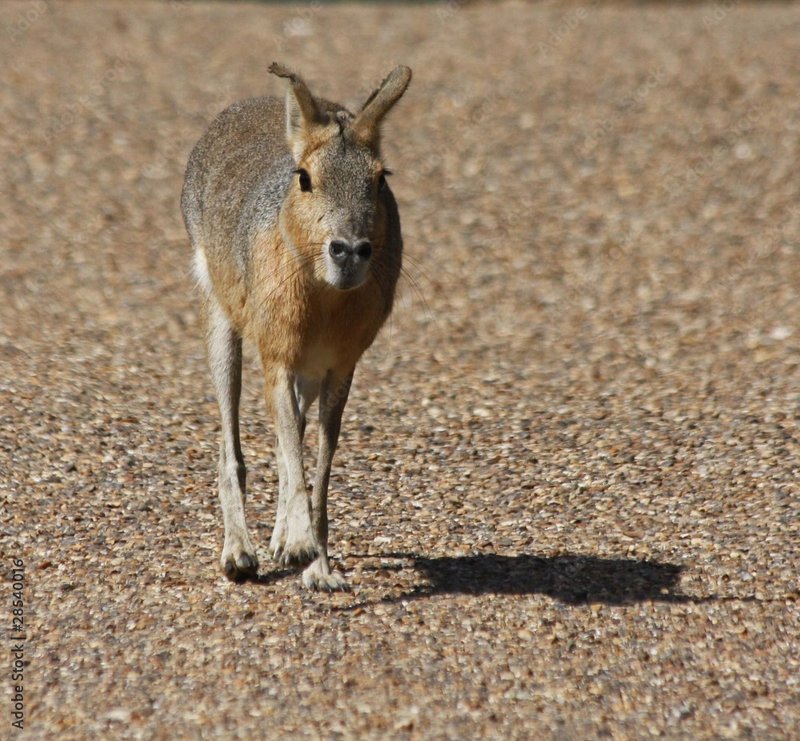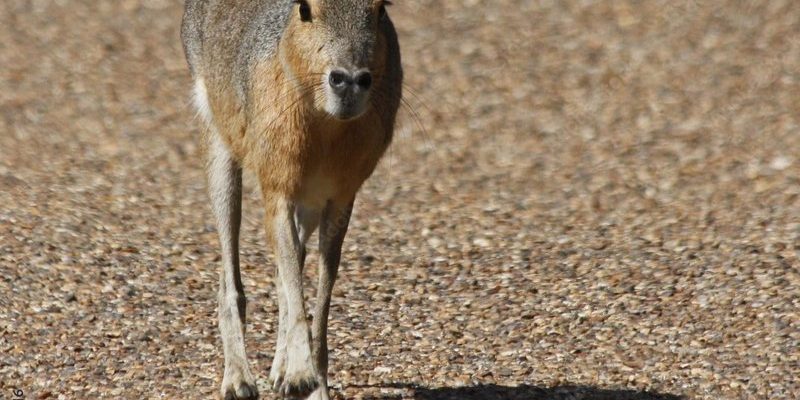
The Patagonian Mara is one of those animals that truly stand out. With its long legs and large ears, it looks like a cross between a rabbit and a small deer, which is both curious and charming. Found primarily in the arid grasslands of Argentina’s Patagonia region, this fascinating creature captures the hearts of many wildlife enthusiasts and casual observers alike. Imagine a small gazelle gracefully leaping across the open plains, and you start to get a sense of what the Patagonian Mara is all about.
But here’s the thing: there’s so much more to these animals than just their striking appearance. Their behaviors, social structures, and habitats paint a vivid picture of life in the wild. The Patagonian Mara is not just a pretty face; it plays a significant role in its ecosystem and has unique adaptations that help it thrive in a challenging environment. So, let’s dive in and explore the world of the Patagonian Mara together!
Physical Characteristics
The Patagonian Mara is quite distinct in its physical build. Typically, they weigh around 24 to 35 pounds and can reach lengths of about 2.5 feet from nose to tail. Their long legs allow them to run at impressive speeds, reaching up to 30 miles per hour when startled. This ability to sprint is crucial for evading predators, including foxes and birds of prey, that threaten these small mammals.
One of the most notable features of the Patagonian Mara is its large, expressive ears. These ears are not just for show; they play a crucial role in their survival. They help the mara pick up sounds from far distances, allowing it to detect predators. The coat of the mara is another feature worth mentioning. With a mix of gray and brown fur, it provides excellent camouflage among the rocky terrains and sparse vegetation of its habitat.
If you happen to spot a Patagonian Mara, you might notice its curious behavior as well. They have a unique way of interacting with one another, especially during their grazing sessions. Often, you’ll see them taking turns watching for danger while the others eat, showcasing their cooperative nature.
Habitat and Range
The natural habitat of the Patagonian Mara primarily consists of open grasslands and scrublands, which can be found in the southern regions of Argentina. These areas provide the necessary resources for their survival, such as food and shelter from predators. However, it’s important to note that these habitats can sometimes be harsh, with dry spells and extreme temperatures.
Interestingly, these animals tend to prefer areas with low, sparse vegetation. This preference is not just for dietary reasons; it also aids them in spotting potential threats from a distance. Their range generally covers the central and southern parts of Patagonia, an area that has been designated as an important ecological zone due to its unique biodiversity.
Unfortunately, the habitat of the Patagonian Mara has come under threat. Human encroachment and agriculture are rapidly changing the landscape. As a result, their population has seen significant declines, which makes conservation efforts even more vital today. The challenge lies in finding a balance between development and preserving these unique ecosystems.
Diet and Feeding Habits
When it comes to food, the Patagonian Mara is primarily herbivorous. Its diet consists mainly of grasses, herbs, and leaves, tailored to thrive in its arid habitat. They are selective feeders, often choosing the most nutritious plants available. This selective nature helps them maintain their health, especially in a challenging environment with limited resources.
Interestingly, Patagonian Maras are known to be crepuscular, meaning they are most active during the early morning and late afternoon. During these times, they venture out to graze and search for food. It’s fascinating to observe them as they meticulously nibble on grasses, using their strong front teeth to shear off plant material.
Another thing to note is their unique digestive system. Like many herbivores, they have a specialized gut that allows them to efficiently break down tough plant materials. They often engage in a behavior called coprophagy, where they eat their own feces to extract more nutrients. This might sound unappealing, but it’s a natural behavior that helps them maximize their nutrient intake!
Social Structure and Behavior
The social structure of the Patagonian Mara is quite intriguing. Generally, they form monogamous pairs, often staying together for life. This means that once they find a mate, they stick by each other through thick and thin. Watching a couple of maras interact can be quite endearing, as they groom each other and maintain close physical contact, reinforcing their bond.
In addition to their pairing system, Patagonian Maras are known for being social animals. They often gather in small groups, which can provide added safety in numbers when foraging for food. Interestingly, one individual will take on the role of the lookout, remaining vigilant while the rest of the group eats. This cooperative behavior enhances their chances of survival in the wild.
You might be wondering how they communicate. Patagonian Maras use various vocalizations and body language to express different emotions and alerts. When startled, they emit high-pitched calls to warn others of danger. It’s as if they have a built-in alarm system, showcasing the remarkable ways they interact within their social groups.
Conservation Status
The conservation status of the Patagonian Mara is a matter of growing concern. Currently listed as Near Threatened, their populations have been significantly impacted by habitat loss due to agricultural expansion and urban development. As human activities continue to invade their natural habitats, these animals face increasing challenges to their survival.
Conservation organizations are working tirelessly to protect the Patagonian Mara and its habitat. Efforts include habitat restoration and creating protected areas to ensure that these creatures have safe spaces to thrive. Local communities are also being educated about the importance of preserving wildlife, fostering a sense of stewardship toward these unique animals.
It’s important for us as global citizens to support these efforts. By raising awareness and promoting sustainable practices, we can help protect the Patagonian Mara and many other wildlife species facing similar threats. Every small action counts, and collaboration between organizations, governments, and local communities can make a difference!
Interesting Facts
| Size | 24 to 35 pounds |
| Length | Approximately 2.5 feet |
| Speed | Up to 30 miles per hour |
| Diet | Herbivorous – primarily grasses and herbs |
| Lifespan | Up to 10 years in the wild |
| Social Structure | Monogamous pairs |
FAQ
What is the natural habitat of the Patagonian Mara?
The Patagonian Mara mainly inhabits dry, open grasslands and scrublands found in southern Argentina. These areas provide the right balance of food resources and shelter. The maras have adapted to thrive in these arid environments, where they can often be seen foraging for plants.
Are Patagonian Maras endangered?
While currently classified as Near Threatened, Patagonian Maras face significant threats due to habitat loss and degradation from agricultural practices and urbanization. Conservation efforts are in place to protect them, but their population numbers are still a concern.
How long do Patagonian Maras live?
In the wild, Patagonian Maras typically have a lifespan of up to 10 years. However, in protected environments, they may live longer due to the absence of predators and a stable food supply.
What do Patagonian Maras eat?
Patagonian Maras are herbivorous animals that primarily feed on various grasses, herbs, and leaves. They’re selective eaters and often graze during the early morning and late afternoon when temperatures are cooler.
How fast can a Patagonian Mara run?
These incredible animals can reach speeds of up to 30 miles per hour when they need to escape from predators. Their long legs provide them with the agility and speed necessary for quick evasions.
Do Patagonian Maras live in groups?
Yes, Patagonian Maras are social animals. While they form strong monogamous pairs, they also gather in small groups during foraging. This social structure allows them to keep watch for predators while feeding.
What adaptations do Patagonian Maras have for survival?
Patagonian Maras have adapted to their harsh environments with excellent hearing through their large ears, strong legs for running, and a digestive system that allows them to efficiently extract nutrients from tough plant materials.
Why are conservation efforts important for Patagonian Maras?
Conservation efforts are crucial for Patagonian Maras because their populations are declining due to habitat loss. Protecting their habitats ensures that these unique animals can thrive and maintain ecological balance in their native ecosystems.
Can Patagonian Maras be kept as pets?
While Patagonian Maras are incredibly charming, they are wild animals and are not suitable as pets. They have specific dietary and habitat needs that are difficult to meet in a home environment, and it is often illegal to keep them without special permits.
What role do Patagonian Maras play in their ecosystem?
Patagonian Maras play an important role in their ecosystem by helping with plant growth. By grazing, they contribute to the health of the grasslands and help in seed dispersal. Their presence supports a diverse range of flora and fauna in their habitats.
How can I help protect Patagonian Maras?
You can help protect Patagonian Maras by supporting conservation organizations, spreading awareness about their plight, and practicing sustainable behaviors in your own life. Every small action can contribute to the preservation of wildlife and their habitats.

